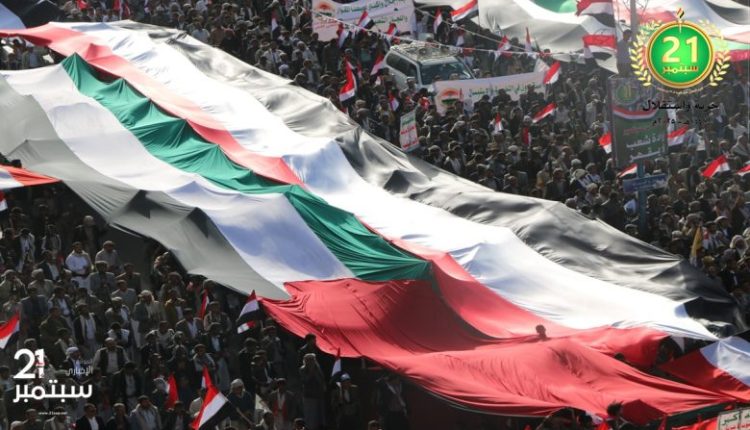September 21: From Overthrowing Guardianship to Supporting Gaza and Forging Epics of Dignity
When the dawn of September 21, 2014 broke, it was not merely the beginning of a new day—it was the birth of a different era, a historical earthquake that redefined the meaning of freedom and sovereignty in a country long subjected to foreign tutelage.
Eleven years have passed, and the September 21 Revolution has transformed from a local event to end guardianship and dependency into an Arab and Islamic beacon—one that inspires nations, unsettles tyrants, and writes new chapters in the history of resistance against arrogance and domination.
Today, as we light the flame marking the eleventh anniversary of this glorious revolution, Yemen stands tall—not only as a country that withstood a brutal coalition war, but as the spearhead of the Ummah in Gaza’s struggle, on land and sea, in both military and political arenas.
The September 21 Revolution: Birth of a New Yemen
The September 21 Revolution did not emerge from a vacuum; it arose from a reality burdened by corruption, subjugation, and dependency. Yemen was living on the margins of its own sovereignty—chained by the dictates of foreign ambassadors, divided by schemes of fragmentation and domination. The revolution declared the final word: No more guardianship, no more subservience, no more dependency.
With this spirit, Yemenis toppled the system of tutelage and laid the foundation for a new era based on independence and sovereignty, setting the first stones of a new Yemen: a sovereign national army, independent political decision-making, and an economy striving to free itself from external control.
Achievements: From Building Power to Breaking Hegemony
Rebuilding a National Army
The revolution restored dignity to the Yemeni armed forces, once fragmented and stripped of will. Today, Yemen’s military ranks among the most notable in the region, with indigenous development, advanced missile and naval capabilities that have shaken Israel and challenged American dominance in the Red Sea.
Economy of Resilience
Despite siege and aggression, the September 21 Revolution proved that willpower creates alternatives. Projects of self-sufficiency, agricultural revival, resource protection, and independence from oil dependency have laid the foundation of a resistant economy built on dignity rather than dependency.
Commitment to the Ummah’s Causes
The revolution did not stop at Yemen’s borders. It expanded its scope to place Palestine at its core. It turned from a national project into a universal one, affirming that Yemen’s freedom is inseparable from Gaza’s freedom, and that the fight against global arrogance is one battle stretching from Saada to Jenin.
Yemen and Gaza: From Slogans to Action
The Popular Stance
At a time when Arab capitals fell silent and rushed toward normalization, Yemen’s people filled the squares by the millions, chanting “Death to America, Death to Israel,” linking their internal struggle with the Ummah’s greater battle. The weekly scenes in Sana’a, Saada, and Hodeidah became a unique Arab phenomenon, unmatched in modern history.
The Military Stance
The slogans were not mere words but translated into action. Yemen’s armed forces opened a new phase in the struggle against Israel: crippling naval blockades, precision missile strikes, operations that rattled American fleets, and ballistic and hypersonic missiles reaching deep into occupied territories.
These operations not only supported Gaza but also shattered Israel’s myth of deterrence, proving that Yemen has emerged as a regional power to be reckoned with.
The Political Stance
Thanks to the September 21 Revolution, Yemen now makes independent decisions free of Washington’s embassies or Riyadh and Abu Dhabi’s dictates. Today, Sana’a’s voice is heard internationally as the representative of a people’s will, not a regime’s whims. Its steadfast position on Palestine has exposed the compromises of other regimes and redefined the essence of Arabism and Islam.
Yemen Versus the Axis of Evil: U.S., U.K., and Israel
For the first time in the region’s modern history, an Arab state confronts U.S. fleets directly, imposing new rules of engagement. From the Red Sea to the Gulf of Aden, from occupied Palestine to the far reaches of the Mediterranean and Indian Ocean, Yemen is present as a disruptive regional actor against imperial designs.
The U.S. and Britain failed to protect Israeli vessels, and failed to subjugate Yemen despite a decade of war and blockade. The result: a stronger people, a more rooted revolution, and a new equation that makes Sana’a the capital of a resistance axis impossible to ignore.
A Revolution Shaping the Future
The September 21 Revolution is not just an anniversary to be celebrated, but a renewed covenant—embodied today in supporting Gaza and breaking U.S. hegemony. It is a revolution that proved when peoples possess the

